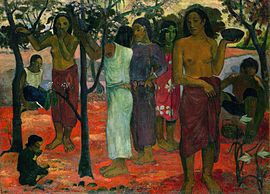Nave Nave Mahana
| Nave Nave Mahana (Delicious day) | |
|---|---|
 | |
| Artist | Paul Gauguin |
| Year | 1896 |
| Type | Oil painting |
| Dimensions | 95 cm × 130 cm (37 in × 51 in) |
| Location | Museum of Fine Arts of Lyon, Lyon |
Nave Nave Mahana (Tahitian: Delicious day) was made in 1896 by Paul Gauguin in Tahiti. It is kept in the Museum of Fine Arts of Lyon. The painting became part of the collections of the Lyon Museum in 1913.
History[]
In 1891, Gauguin sailed to Polynesia to escape the evils of European civilization and "everything that is artificial and conventional". To his disappointment, Polynesia was already tainted by European influences when he first arrived in his long-dreamed-of paradise.[1]
His works of that period are full of quasi-religious symbolism and an exoticized view of the inhabitants of Polynesia.
In 1896, he painted Nave Nave Mahana in Tahiti after he came back from a short stay in France.[2]
Subject[]
A group of mysterious young women seem to be gathering fruit from the branches of plants. Their feet are solidly anchored on the red ground. Behind them, we can see a yellow sky. Frozen, distant, silent, with eyes cast down and solemn faces, the figures are perhaps a revealing indication of the artist's isolation and ill health at the time of painting.[3]
Notes and references[]
- ^ Roberta Smith (13 March 2014). "The Man, Not the Myth". The New York Times.
- ^ "Nave Nave Mahana". Massachusetts Institute of Technology Libraries.
- ^ Charles Juliet (19 Oct 2006). "Nave Nave Mahana". www.mba-lyon.fr.
- 1896 paintings
- Paintings by Paul Gauguin
- Paintings in the collection of the Museum of Fine Arts of Lyon
- 19th-century painting stubs